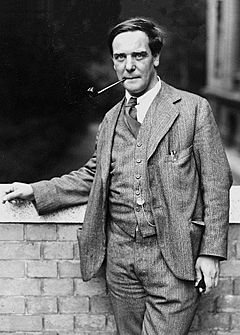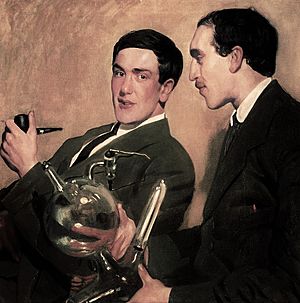Pyotr Kapitsa facts for kids
Quick facts for kids
Pyotr Kapitsa
|
|
|---|---|
| Пётр Капица | |

Pyotr Kapitsa in the 1930s
|
|
| Born |
Pyotr Leonidovich Kapitsa
8 July 1894 Kronstadt, Russian Empire
|
| Died | 8 April 1984 (aged 89) |
| Resting place | Novodevichy Cemetery, Moscow |
| Citizenship | |
| Known for | Superfluidity Kapitza instability Kapitza number Kapitza resistance Kapitsa's pendulum Kapitsa–Dirac effect |
| Awards |
|
| Scientific career | |
| Fields | Physics |
| Institutions | Moscow State University |
| Doctoral students | David Shoenberg |
Pyotr Leonidovich Kapitsa (born July 8, 1894 – died April 8, 1984) was a famous Soviet physicist. He won the Nobel Prize in Physics for his important work. He is best known for studying how things behave at very cold temperatures.
Contents
Pyotr Kapitsa's Life Story
Pyotr Kapitsa was born in Kronstadt, which was part of the Russian Empire. His father was a military engineer who built strong defenses. His mother came from a noble Polish family.
Kapitsa's studies were stopped by World War I. He worked as an ambulance driver for two years. He finished his degree in 1918. Sadly, his wife and two children died during a flu sickness around that time.
After this, he moved to Britain. He worked for over ten years with a famous scientist named Ernest Rutherford. This was at the Cavendish Laboratory at the University of Cambridge. He also started a group called the Kapitza club.
From 1930 to 1934, he was the first director of the Mond Laboratory in Cambridge.
Amazing Discoveries in Physics
In the 1920s, Kapitsa found ways to make super strong magnetic fields. He did this by sending a lot of electricity through special magnets for a short time.
In 1928, he found that how easily electricity flows through some metals changes a lot in very strong magnetic fields.
In 1934, Kapitsa went back to Russia to visit his family. But the Soviet Union would not let him return to Great Britain.
Since his special equipment for strong magnetic fields was still in Cambridge, he started studying very cold things. He looked at how to make things super cold. In 1934, he created new machines to make large amounts of liquid helium.
Kapitsa then started the Institute for Physical Problems in Russia. The Soviet government bought some of his equipment from Cambridge. Ernest Rutherford helped with this, knowing Kapitsa could not come back.
In Russia, Kapitsa did many experiments with liquid helium. In 1937, he found something amazing: superfluidity. This is a state where liquid helium flows with no friction at all. It's different from superconductivity, where electricity flows without resistance.
He wrote many papers about this new state of matter. Later, he won the Nobel Prize in Physics for these "basic inventions and discoveries in the area of low-temperature physics."
War Efforts and New Inventions
In 1939, he found a new way to turn air into liquid. He used a special, very efficient turbine. During World War II, he led the Department of Oxygen Industry. He used his new methods to make oxygen for factories.
He also invented powerful microwave generators between 1950 and 1955. He discovered a new type of plasma discharge. This plasma could reach temperatures over 1,000,000 degrees Kelvin!
Standing Up for Science
In 1945, Kapitsa had a disagreement with Lavrenty Beria. Beria was in charge of the Soviet atomic bomb project. Kapitsa wrote to Joseph Stalin, the leader, saying Beria didn't understand physics. Stalin told Beria to work with the scientists.
Kapitsa refused to meet Beria, telling him to come to the Institute instead. Stalin offered to meet Kapitsa, but it never happened.
After the war, Kapitsa and other scientists helped create a new university. It was the Moscow Institute of Physics and Technology. Kapitsa taught there for many years. He was also a member of the Academy of Sciences of the Soviet Union. He was the only member who was not part of the Communist Party.
In 1966, Kapitsa was allowed to visit Cambridge again. He went to receive the Rutherford Medal and Prize. When he went to dinner at his old college, Trinity, he didn't have his special gown. A servant found his exact gown from 32 years before!

In 1978, Kapitsa won the Nobel Prize in Physics. It was for his work in low-temperature physics. He shared the prize with Arno Allan Penzias and Robert Woodrow Wilson. They won for finding the cosmic microwave background, which is like an echo from the Big Bang.
Kapitsa's Legacy in Science
The term Kapitsa resistance describes how heat struggles to move between liquid helium and a solid. The Kapitsa–Dirac effect is a quantum idea. It shows how electrons can be bent by light waves. In how liquids flow, the Kapitza number helps describe thin films of liquid moving down a slope.
His Family and Friends
Kapitsa married Anna Alekseyevna Krylova in 1927. She was the daughter of a famous mathematician. They had two sons, Sergey and Andrey.
Sergey Kapitsa (1928–2012) was a physicist and also studied populations. He was known as "Centaurus." This nickname came from a story. Someone asked if his supervisor was human or a beast. The answer was "Centaurus," meaning he could be human but also get angry like a horse. Sergey also hosted a popular Russian science TV show.
Andrey Kapitsa (1931–2011) was a geographer. He is known for finding and naming Lake Vostok. This is a huge lake hidden 4,000 meters under the ice in Antarctica.
Kapitsa had influence with high-ranking people in the Soviet government. His discoveries were very useful for industry. He often wrote letters about science. He even helped save other scientists, like Vladimir Fock and Lev Landau, during a difficult time in the 1930s. He told a leader that Landau was the only one who could solve a big physics problem.
Pyotr Kapitsa passed away on April 8, 1984, in Moscow. He was 89 years old.
Awards and Recognition
A small space rock, 3437 Kapitsa, was named after him. It was found by a Soviet astronomer in 1982. He became a Fellow of the Royal Society (FRS) in 1929. In 1958, he became a member of the German Academy of Sciences Leopoldina.
Here are some of his other important awards:
- Hero of Socialist Labour (1945 and 1974)
- Stalin Prize, 1st class (1941 and 1943)
- Nobel Prize in Physics (1978)
- Lomonosov Gold Medal (1959)
- Order of Lenin (1943, 1944, 1945, 1964, 1971)
- Order of the Red Banner of Labour (1954)
See also
 In Spanish: Piotr Kapitsa para niños
In Spanish: Piotr Kapitsa para niños
- Ball lightning
- Basic oxygen steelmaking
- Bipolar battery
- Cliodynamics
- Quantum hydrodynamics
- Reynolds equation
- Kapitza Club
- Kapitza Institute

